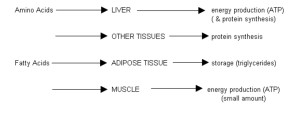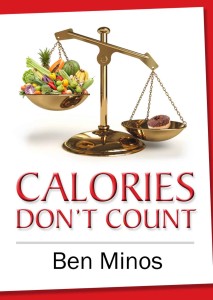TCC The Science of Fat Loss Series Part 5 – The Fasting State
Last instalment we covered The Fed State, which is what is happening in the body immediately after you ingest a meal.
This week we will explore what happens between meals and during the overnight period. Something that is also known as The Fasting State. For scientists, this also equates to their version of The Fat Burning State.
The Fasting State (aka Fat Burning Mode)
A few hours after your meal, blood glucose levels begin to decline. Your body decreases its Insulin secretion and Glucagon secretion starts to rise.
Just as insulin signalled the Fed State. Glucagon signals the Fasting State.
Glucagon is therefore the main antagonist to insulin. Wait, wait, wait. I know in previous instalments we discussed Adrenalin as being the main opponent to Insulin. And this is still correct. As far as your fat cells go! BUT. Glucagon has NO EFFECT on human fat cells. So, your fat cells don’t care about Glucagon. So what gives? This is the prime example of how scientists and their definition for certain states are extremely myopic and small minded when it comes to how the body works. All they are concerned about when discussing these states is purely blood sugar levels and blood sugar maintenance. Rarely do they discuss tissue specific responses in correlation with each other.
So, the main target of Glucagon is your liver. Glucagon signals the liver to start releasing some glucose to keep blood sugar levels stable. Your muscles though, are pretty selfish and don’t listen to Glucagon. Your muscles actually lack the enzyme to release stored glucose back out in to the blood stream. Once glucose is stored in your muscles it stays there until the muscle itself uses it up. It won’t release it back in to the blood stream for your brain to use! Think about the implications of this for a minute. We are constantly drilled in to your heads how important glucose is for your brain. That your brain mainly uses it as its primary fuel source and can’t function properly without it. And yet your body stores MOST of your carbohydrate stores (even up to 3-5 times greater) in a place where the brain will never have access to it! Your body obviously values the principle of “fight or flight” over the maintenance of blood glucose for the brain. This will have important implications later for the timing of your carbohydrate intake. Anyway, I digress…
During this period of lowering glucose, your body keeps blood sugar stable in 3 ways:
1) Your liver releases it’s stored glucose – any glucose that was stored in the liver after the previous Fed State will now start to be released in order to maintain a normal blood glucose level.
2) Your body releases more fatty acids – your body will start to release more fatty acids in order to have them available for an alternative source of energy in order to preserve blood glucose.
3) Your muscles and liver shift to use more fatty acids for energy – Just as your body made more fatty acids available, your muscles and liver switch their metabolic processes to now burn more fatty acids. This all has a “glycogen sparing” effect.
This is why it’s also sometimes known as The Fat Burning state. This is the type of environment where your body is releasing more and more fatty acids and your body switches to mainly uses the fatty acids as a fuel source. If you are in the Fasting State, you are usually in a Fat Burning state.
What happens once liver stores of glycogen are depleted?
Remember, one of the primary roles of your liver is to maintain nice steady and stable blood glucose levels. So, what do you think your liver does if you haven’t eaten anything and it has run out of its own supply?? It starts making its own glucose! It’s a process called gluconeogenesis. This process mainly occurs in the liver, and it is for this reason your brain doesn’t get too panicky about the muscle not releasing any glucose! It knows the liver has got its back, and will make glucose for it if needed.
Where does your body get the raw materials to make glucose from?
It’s impossible for your body to make fat in to glucose, but it can use some of those glycerol backbones we’ve already spoken about. The other substrate it can use are amino acids. If you haven’t eaten any or enough protein, your body will start to break your muscles to get it. Obviously not a good state to be in if you want to keep your gains while stripping fat. This is one of the reasons why, if you are on a lower carbohydrate intake, you may have to increase your protein intake even more to compensate for this.
The ReFed State (after an overnight fast)
An interesting thing happens if your body has gone through a slightly longer fasting period, as what happens after an overnight fast.
If you wake up in the morning and have a meal, any fats you eat will still get processed the exact same way.
Curiously though, even if you eat carbohydrates, your liver doesn’t stop making its own glucose. At least not yet.
Any glucose you do eat is actually shunted away to your muscles for them to get “first dibs” on it. While this is going on, your liver actually keeps making its own glucose, but now it uses it to fill up its own glycogen stores. This also has some implications for nutrient timing to be covered later. It is also for this reason some people recommend partitioning half of your daily carbohydrate intake between the post workout meal and your first meal of the day.
Once your muscles have their fill. And the liver stores fill up. The liver starts making fatty acids again. Obviously, the magnitude of all of this is largely dependent upon HOW MUCH of each macronutrient you have eaten. Yes, amounts of macro’s still do matter.

Fasting diets
Just because scientists talk about the Fed State as being after a meal. They never stipulate exactly what the composition of that meal is. Read any text book and they will all talk about the Fed State as after you have insulin being released in response to a large enough carbohydrate meal.
Obviously, The Fed State is not an ideal metabolic environment to be in when you are trying to lose fat. Your body is in fat storing mode.
The Fasting State (at least metabolically mimicking this) is the state you want your body to be in for fat loss to take place.
How do you affect the most fat loss then? Well, that’s easy. Spend more time in the Fasted State than what you do in the Fed State right?
This is the principle and theory behind the rise, and also a reasonable amount of success, in the popularity of fasting diets. Or variations of, such as with intermittent fasting. These diets seek to prolong this fasting state, so you can stay in a fat burning mode longer.
Another benefit of Fasting is it also improves your insulin sensitivity and glucose tolerance. Even though the fasted state has been studied, it has literally only been the last couple of years that researchers are again looking at the benefits of prolonged and intermittent fasting as a treatment modality of obesity. Not only can you control peoples energy intake this way, you also serve to improve their glucose tolerance, which helps a great deal in Type II diabetes management.
But. The fasting state is not without consequence. If blood glucose levels remain low over an extended period, your body will literally start cannibalising itself in order to get what it needs to make more. So you will be at a greater risk losing muscle. Remember, your body can’t convert fat in to glucose, but it can convert amino acids in to glucose. If you don’t have enough ingested orally through the foods you eat, your body will have no choice but to eat in to its own flesh to unlock some.
If only the was a way to mimic this fasting state without eating in to your hard earned gym gains…
Also remember, this is only looking at a small piece of an overall puzzle. There are other factors that influence the flux of a fat cell beyond what happens after a meal and what happens between meals.
Key Points
1) Fasting State = releasing mode = ideal for fat burning
2) Fasting State by scientific definition is several hours after a meal and is characterised by Glucagon
*I’m not condoning nor condemning fasted diets. Only giving you the background and principle on which they are founded and the science of why they work. It is up to you whether you believe this is the best method to decrease body fat. I wouldn’t necessarily be making that conclusion half way through the series though…
Things you should be asking yourself at this stage:
Is there is a way to manipulate the Fed and Fasting states by changing the composition of your meals and by also changing the timing of your meals?
Could you somehow mimic the fasting state, but offset the potential muscle loss?
Could you somehow manipulate your carbohydrate intake to prolong the fasting state, but still have enough to recover and fuel your training sessions?
Can you think of some ways of doing this before we continue with Part 5.1??
 Ben Minos has Bachelor degrees in both Physiotherapy and Exercise Science (Human Movements). He has worked as a Personal Trainer for 20 years and a Physiotherapist for close to 15. Ben has authored a book on nutrition titled
Ben Minos has Bachelor degrees in both Physiotherapy and Exercise Science (Human Movements). He has worked as a Personal Trainer for 20 years and a Physiotherapist for close to 15. Ben has authored a book on nutrition titled